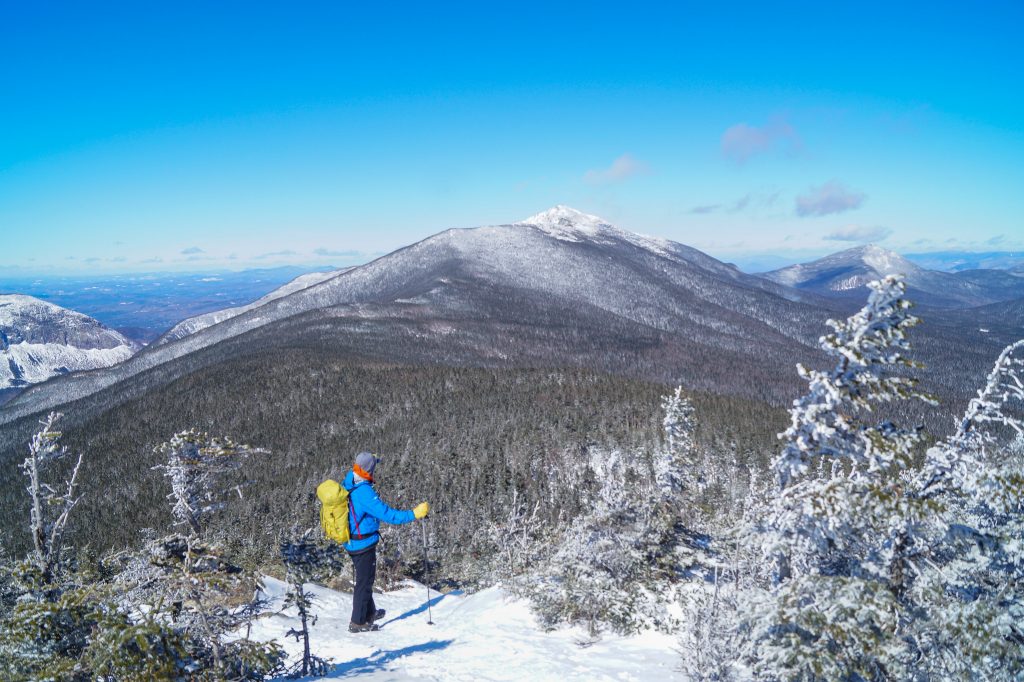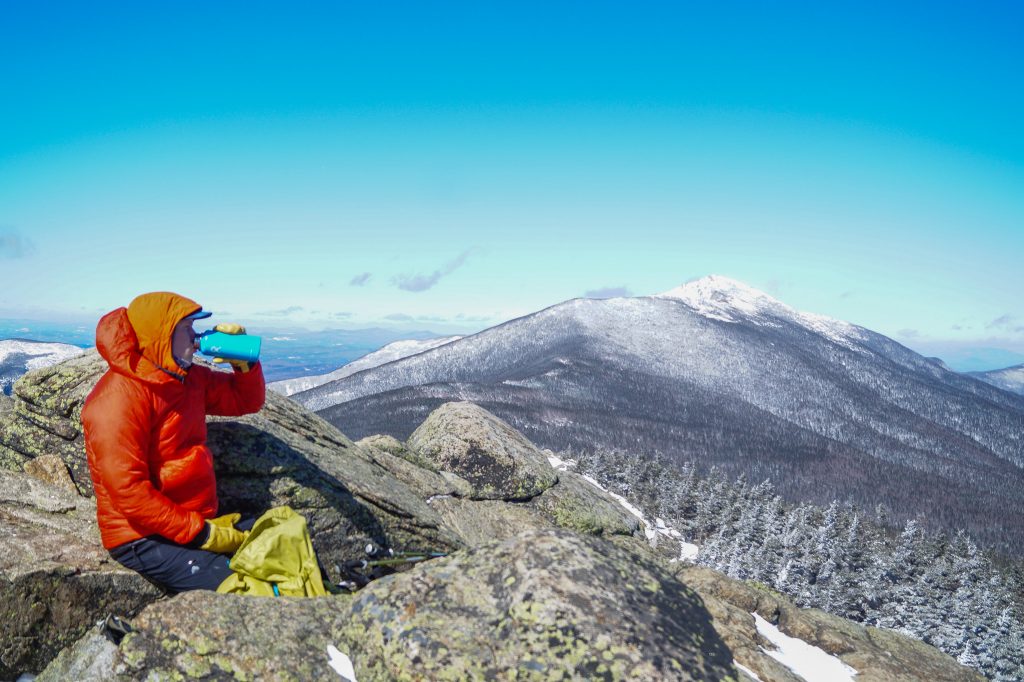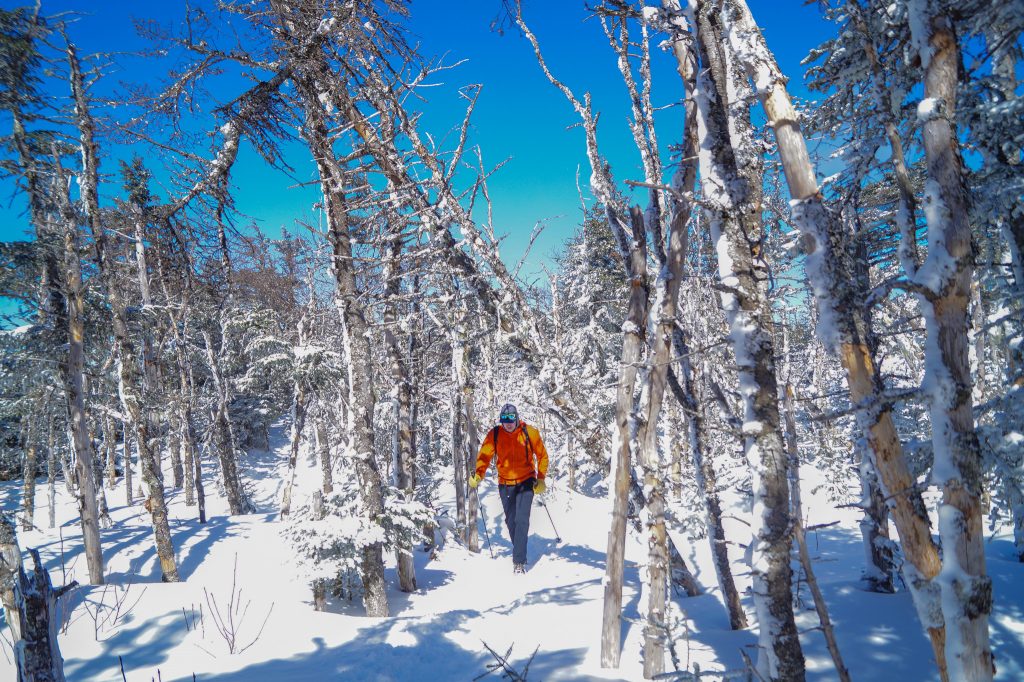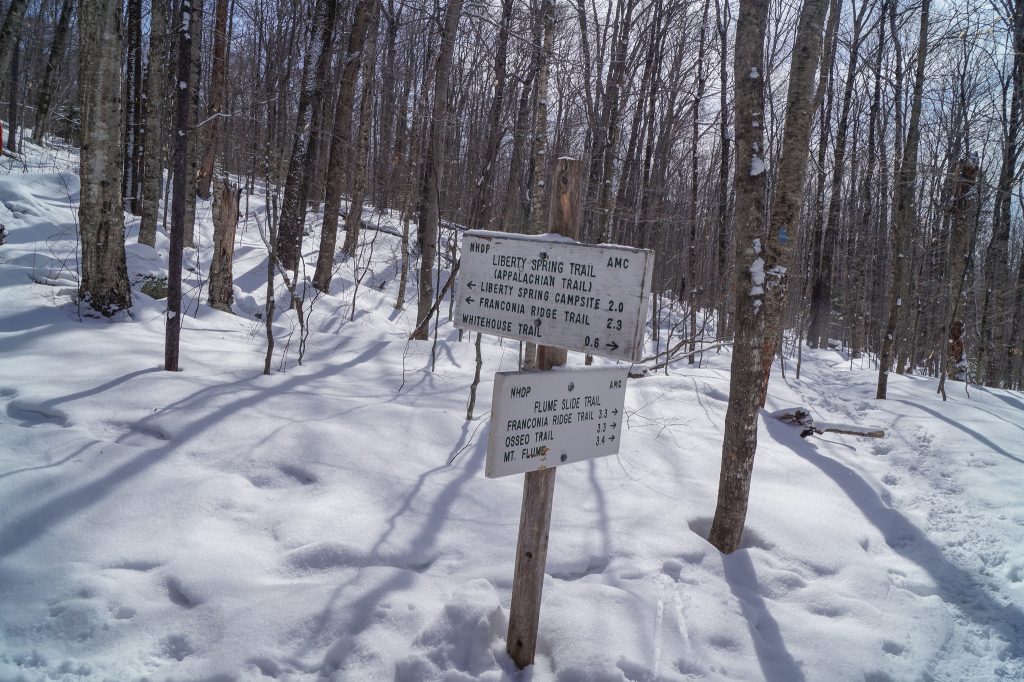Largely below treeline but with breathtaking summit views—and a convenient location just off I-93—an ascent of Mount Liberty in Franconia Notch is one of the more popular shoulder-season hikes in the Whites. Not quite winter and not yet spring, a shoulder-season climb presents a handful of challenges to hikers: conditions can change quickly and yesterday’s monorail might be today’s ankle-deep mud. The best way to deal with the variable terrain and ever-changing conditions found on Mount Liberty and ensure yourself a successful summit is with the right gear.
Jackets
A three-jacket system—two puffies and a hardshell—is a sure way to stay warm and dry on a shoulder-season hike of Mount Liberty. If the weather is particularly fickle or you like to have a lot of layering options, consider adding a windshirt to your kit.
Two Puffies
Franconia Notch is often a wind tunnel and can feel significantly colder than the thermometer says it is. This is especially true above treeline on the summit ridge, where the Liberty Springs Trail ends and hikers follow the Franconia Ridge Trail south for a little over a quarter mile to Liberty’s summit.
A puffy with active insulation is ideal for staying warm while on the move, as it provides warmth while also venting excess heat. The downside of active insulation is that it’s air-permeable. In other words, it lets air in—like bitter winter winds—as well as it does out. Because of this, you’ll want to pair it with a traditional puffy such as the EMS Feather Pack Hooded Jacket (men’s/women’s) for when you stop, like when taking in Mount Liberty’s 360° summit view and incredible perspective of mountains like Loon, Cannon, Lafayette, and the Bonds.Hardshell
It sometimes seems like Franconia Notch has its own weather. It’s common to enjoy warm spring weather at the trailhead only to encounter freezing temperatures, biting wind, and even snow on the summit. A waterproof and windproof hardshell like the Marmot Minimalist Pro (men’s/women’s) protects against snow, rain, wind, and whatever other weather Franconia Notch throws at you.

Accessories
Accessories are generally small items but they can make a big difference in keeping you comfortable and safe on a shoulder-season ascent of a 4,000-footer.
Gloves and Mittens
Large temperature fluctuations are a staple of shoulder season, especially when you change elevations. Bare hands at the base of the mountain may be comfortable on some spring days, but you’ll likely find yourself wishing for a light pair of fleece gloves—like the Outdoor Research Vigor (men’s/women’s)—around the 2.5-mile mark as you pass Liberty Springs Tentsite.
The only thing worse than not packing a pair of lightweight gloves is forgetting to also carry a warm pair of mittens in your pack for when you reach Liberty’s exposed summit. The EMS Ascent Summit Mitt (men’s/women’s) is a long-time favorite.
Trucker and Winter Hat
The gradual nature of the Liberty Springs Trail means motivated hikers can move fast for the first few miles. A good old-fashioned trucker hat, like the Outdoor Research Advocate, is a great choice for keeping the sun and sweat out of your eyes while moving quickly on the trail. Stash a traditional winter hat, like the Smartwool NTS 250 Cuffed Beanie, in your pack or pocket to pull on during rest breaks and for above treeline.
Buffs
Just below Liberty’s summit, there’s a short, treeless section that hikers must traverse to the top. Often windy, a Buff makes a great face covering here, protecting sensitive areas like your nose and ears from Franconia Notch’s chilly winds. (Also, in late spring, Buffs treated with Insect Shield are a nice way to fend off the black flies frequently found at lower elevations while the UV-treated versions provide extra sun protection on those sunny spring days and from reflected sunlight from the snow.)

Footwear and Traction
From keeping your feet warm, dry, and comfortable to keeping you upright, what you wear on your feet is vital to a successful shoulder season ascent of Mount Liberty.
La Sportiva Nepal Cube GTX
An ascent of Mount Liberty covers a variety of terrain, including the pavement of the Franconia Notch Bike Path, the often snow-covered and muddy Liberty Springs Trail, wet rocks at the bottom of several streams, and the at-times wintry summit ridge. While many hikers will opt for a pair of mid-cut waterproof hiking boots, a true mountaineering boot like the La Sportiva Nepal Cube GTX (men’s/women’s) provides insulation and waterproof performance—ensuring you’re prepared for even the worst conditions. As an added bonus, it’s a lot easier to kick steps up the steep and snowy sections of the Liberty Springs Trail in Nepals than it is in most hiking boots.
Kahtoola MICROSpikes
From the parking lot blacktop to the rocky 4,459-foot summit, snow and ice take a long time to disappear on Mount Liberty. This Franconia Notch classic sees a lot of traffic, meaning you can generally leave the snowshoes at home. However, it can get icy, and having trusted traction devices like Kahtoola MICROspikes ready to go can mean the difference between slipping and sliding every step of the way and confidently speeding up to the summit ridge and back down.

Other Gear to Consider
In addition to having the correct layers and footwear, a few other key pieces of gear can go a long way to ensuring you get to soak up the views from Mount Liberty’s summit.
Trekking Poles
Above the Liberty Springs Tentsite, the trail begins to climb consistently. Depending on snow conditions, this section of trail features a handful of balance-testing challenges for both ascending and descending hikers. A pair of trekking poles like the EMS Approach are handy to have along to provide additional stability over the slippery rocks, ice, and deep snow you’re likely to encounter.
Hydration and Fuel
A summit snack is a fantastic way to celebrate a shoulder-season ascent of Mount Liberty. In cold conditions, warm soup or chili is a tasty treat and provides a nice calorie boost for the descent ahead. Yes, it’s possible to sip warm soup or chow on hot chili on the summit of a mountain—you just need a HydroFlask Insulated Food Jar (8 oz/12 oz/28 oz).
Supplementing your warm snack with some extra calories and a treat is a good call—energy bars, granola, jerky, and other foods that won’t freeze are preferable—especially if you decide to go for a doubleheader. Mount Flume, another 4,000-footer, is just a little over a mile farther south on the Franconia Ridge Trail. Comparatively less traveled and not always broken in, make sure to leave enough time for the out-and-back if you decide to bag it.
On icy shoulder-season days, having something hot to drink is a great way to stay warm and an excellent morale booster. A thermos, like the HydroFlask 24 oz. Standard Mouth Insulated Bottle, is ideal for toting everything from tea to coffee to hot chocolate to the summit of Mount Liberty or your favorite 4,000-footer.

Give Me Liberty
Mount Liberty is one of the best shoulder-season hikes in New Hampshire and a popular place for hikers to find their legs after a long winter. Having the “right” gear along with the 10 essentials can set a positive tone to carry you through the season while showing up unprepared can suck stoke faster than a socked-in summit.
Tim Peck and Doug Martland
Tim and Doug met long ago at the Eastern Mountain Sports in Canton, Massachusetts. Bonding over a love of slick Quincy Quarry granite, White Mountain sufferfests, and scheming up adventures while folding tee-shirts, today Tim and Doug collaborate to write about their favorite outdoor activities and occasionally get nostalgic about tee-shirt tables.




